 The water tower in Bishopville
The water tower in BishopvilleBishopville is a city in Lee County, South Carolina, United States. The population was 3,670 at the 2000 census. It is the county seat of Lee County.
Early History
For more than a decade before Bishopville got its name in the honor of Jacques Bishop, it was known as Singleton’s Crossroads. The 465 acres (1.9 km²) of land was granted to Jacob Chamber by the state of South Carolina in 1786. Daniel Carter later purchased the property and it was once again sold to William Singleton in 1790. This was where the name Singleton’s Crossroads originated.
The tavern owned by Singleton and his wife sat at the intersection of what was once known as Mecklenburg Road, now named Church Street, and McCallum Ferry Road, now known as Main Street. During that time, the tavern was a stopping place for the stage coach between Georgetown and Charlotte. (Now this intersection involves Highway 15, which at one point was the premier north-south route from New York to Miami.) In 1798, William Singleton died, leaving his wife owner of the tavern until her death in 1820. One year later the land was sold to Jacques Bishop. During this time period the area around present-day Bishopville was said to be composed of mostly wilderness, with only a few scattered, primitive houses.
Although voting for the creation of Lee County and for making Bishopville its county seat occurred in 1892, there was a delay in enacting these votes until February 1902, when it was ruled that Bishopville had met all requirements to be a county seat. This led to the marking of county boundaries, which were along Lynches River, Black River, Scape Ore Swamp, Sparrow Swamp, Long Branch, and Screeches Branch, as well as the development of a courthouse and jail. As surveyed in the parent counties, the main limits followed old roads and artificial limits.
It wasn’t until December 15, 1902 that Bishopville received the good news of their success. To celebrate, the town hosted speeches and the shooting of the old cannon many times repeatedly. This same old cannon is located on the concrete base in front of Lee County’s Courthouse in Bishopville.
Lee County has historically been a leader in cotton production in the state and is the home of the South Carolina Cotton Museum.
Monster
This town is known for the sightings of a reptile-like monster that have been seen in and near a swamp called Scape Ore Swamp. It has supposedly frightened people and damaged some cars. At one point there was a one million dollar reward for anyone who could find and present "Lizard Man."
Parks and Outdoor Attractions

Fryar's Garden
Pearl Fryar's Topiary Garden is the home to one of the most breath-taking attractions in South Carolina. Located at 145 Broad Acres Road in Bishopville, South Carolina, this 3-acre (12,000 m2) garden is visited annually by many tourists. Fryar and his carefully sculptured topiary garden has been featured many times on television specials and in dozens of magazines. His garden offers 3 acres (12,000 m2) of trees and shrubs formed into fanciful spirals, 3-dimensional pieces, pom poms, and other extraordinary shapes that always seem to render visitors awestruck.
Fryar is known nationally for live topiary sculptures. He’s also won many awards as well as being named as South Carolina Ambassador for Economic Development by Mark Sanford in 2003. Fryar revealed that all he wanted to do was have a nice yard and win yard of the month from his hometown of Bishopville, SC.
Emmett Acres Alpaca Farm South Carolina's top breeder of Peruvian and Chilean alpacas. Founded in 1999 by Monty and Randall Gooding on 19 acres (77,000m2), this beautiful farm has continued to produce alpacas of the highest quality and color. This beautiful fiber is second to none in the world. The farm is open to visitors by appointment. Visit the web site at www.alpacas-4-u.com or call 803-428-2161 or 803-428-7222 for reservations.
Lee State Park is one of the best known parks in Lee County. Located at 487 Loop Road in Bishopville, this park hosts just about everything from lake swimming, river fishing, boating, nature trails, show ring, and stables. Year-round, daylight hours, the Civilian Conservation Corps (CCC) workers built the Park during the great Depression. This attractive park is approximately 2,500 acres (10 km²) of land . This park offers picnicking in shelters, camping, and a playground. Picnic tables and serene environments are stationed around the 5.6 miles (9.0 km) of Lynches River that's owned by Lee State Park. There are available pedal boat rentals and horse rentals through the nearby Pleasant Valley stables.
Notable natives:
Bishopville is where college football legend, and 1945 Heisman Trophy winner, "Mr. Inside" Felix "Doc" Blanchard was born. The Interstate 20 / U.S. Route 15 interchange near Bishopville is named the Felix "Doc" Blanchard Interchange. The sportsman and pilot will also be commemorated with three bronze statues, scheduled to be unveiled near the public library in December 2009. These statues will depict Blanchard in separate phases of his life.
Pearl Fryar
Bishopville In Pictures:
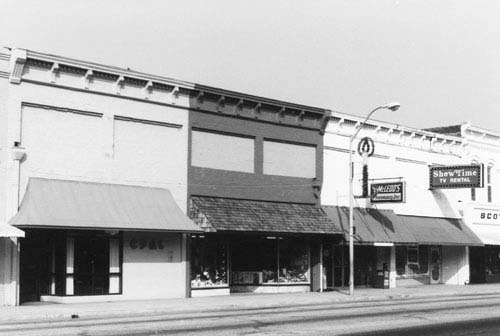
Bishopville Commercial Historic District 121-131 N. Main St. (Constructed: ca. 1905)
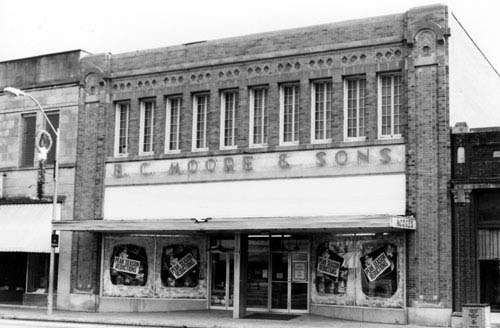
Bishopville Commercial Historic District Moore and Sons, 128 N. Main St. (Constructed: ca. 1920)
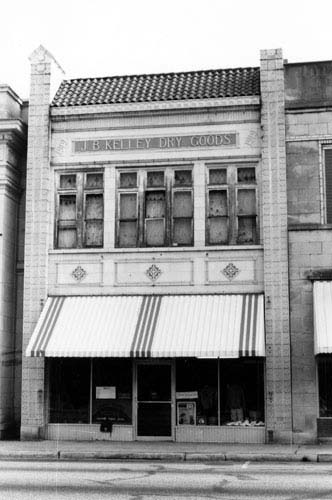
Bishopville Commercial Historic District J. B. Kelley Building, 136 N. Main St.
(Constructed: ca. 1919)
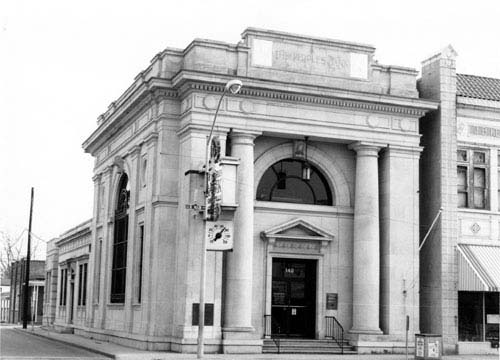
People's Bank, 140 N. Main St. (Constructed: 1912 Style: Neo-Classical)
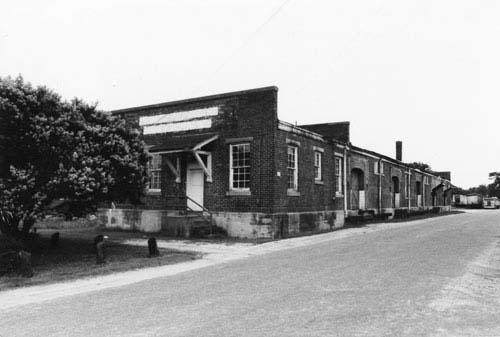
Seaboard Coastline Rail Depot, N. Main St. and Cedar Lane (Constructed: ca. 1915)
James Carnes House, Lee County (200 S. Main St., Bishopville)
Click Here to View Picture
(The Myrtles) The James Carnes House is a good example of the vernacular Greek Revival style and is associated with a prominent Bishopville family of the nineteenth century. This house is one of the oldest in Bishopville with the original main section constructed ca. 1836. This original section was built by James Carnes who was a prosperous merchant and planter. This two-story frame house has a gable roof, weatherboard siding, brick foundation and stuccoed exterior end brick chimneys. The house features a large, two-story, pedimented portico on the main (south) façade. This portico has four larger square, frame columns with Doric motif capitals. At the rear of the house is a larger one-and-one-half story addition, which either was added ca.1900 or was an enlargement of an earlier ell section. At the roofline is a ca. 1900 gable roof dormer with paired four-over-four sash windows. Flanking this gable dormer are two ca. 1920 shed roof dormers. Around 1900 the house was made into a boarding house and the rear section was enlarged or added. The house was operated by James Carnes’s granddaughter, Miss Jeanette Corbett, as a tourist home and apartments during much of the twentieth century. Listed in the National Register January 9, 1986.
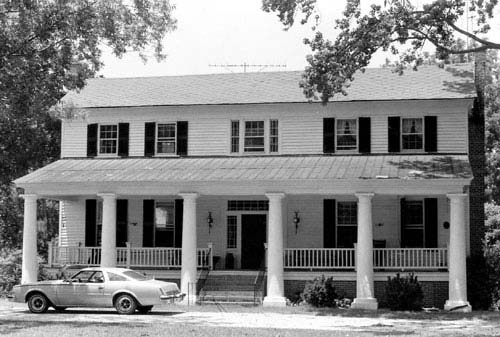
Thomas Fraser House
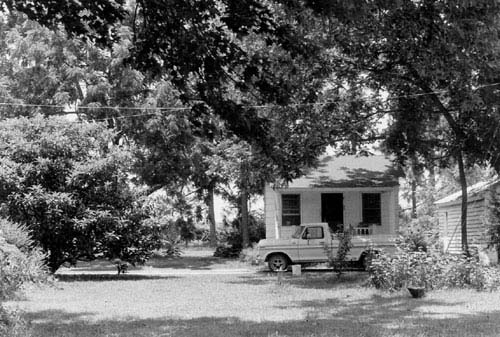
Thomas Fraser House, The Outside Kitchen
(Gregg House) Built in 1847, the Thomas Fraser House is notable example of the vernacular Greek Revival style and is associated with several notable families of Bishopville of the nineteenth and twentieth centuries. The two-story house has a gable roof, weatherboard siding and a brick foundation. The main façade features a one-story porch supported by six round brick and stucco columns with prominent bases and Doric capitals. Behind these freestanding columns is a frame porch with a rectangular railing and spindles. Thomas Fraser was born in 1798 and moved with his family to Bishopville during the early 1840's. Fraser was a farmer and he constructed this house in 1847 according to family tradition and a date carved in one of the chimney bricks. Fraser died in the late 1850s and this property was sold by the family in 1867 to Reverend William Gregg. Gregg was the minister of the Bishopville Presbyterian Church from the 1860's until his retirement in 1904. At the rear of the house is the original kitchen which was remodeled ca. 1900 into a farm office. This one-story building has a porch with milled balusters and round columns. Listed in the National Register January 9, 1986.
William Apollos James House,
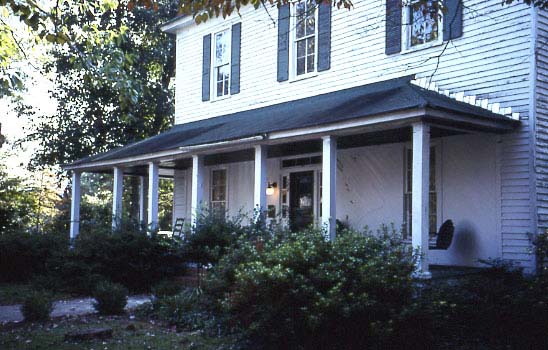
The William Apollos James House, built in 1903 and substantially altered in 1911, is significant as an example of an early twentieth-century vernacular rendition of a Colonial Revival style residence which grew from a modest Folk Victorian cottage. The house was built in 1903 as a lateral-gabled, one-story Folk Victorian cottage with a center gabled dormer. It was occupied by the James family in January 1904. A second story with hip roof, as well as a hip roofed wraparound porch with boxed classical piers, was added in 1911. The house follows the standard central-hall with four-over-four pattern of rooms. The front door, which is original, is framed by a three-light transom and three lights along each side with square and rectangular underpanels. It is also significant for its association with William Apollos James (1857-1930), prominent state representative, agriculturalist, businessman, and community leader of Lee County. Important too is the collection of historic and interesting flora contained within its ornamental and fruit garden. The house is situated in a setting of mature trees and shrubs, and the historic landscape contributes to the significance of the property. Listed in the National Register October 6, 1999.
Lee County Courthouse
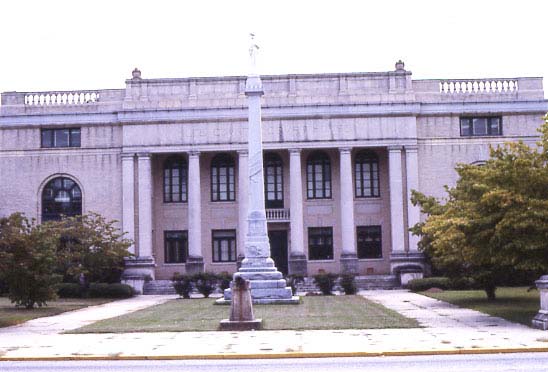
Lee County Courthouse,
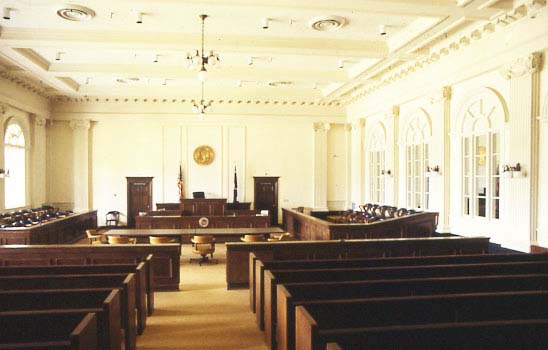
Interior Courtroom
Lee County Courthouse, the first and only courthouse for Lee County, was built six years after the formation of the county in 1902. The courthouse was financed by two bond issues at a cost of $75,000 and was considered one of the finest, most modern courthouses in the state. Lee County, named after Robert E. Lee, was formed from portions of Sumter, Kershaw, and Darlington Counties. The Neo-Classical design, the formality of the composition, and the stone and yellow brick construction suggest a Roman precedent, both of architecture and of law. The courthouse was built in 1908-1909 by contractor Nicholas Ittner of Atlanta. William A. Edwards, of the firm of Edwards and Walter, Atlanta, was the architect. The courthouse is a three-story brick and stone building of Neo-Classical design. A colossal portico in antis defines the façade. The portico features four stone Tuscan columns on stone pedestals, with paired pilaster at the junctions of the portico and the single-bay pavilions which flank the portico. The body of the courthouse is of yellow brick, laid in American Flemish bond, with flush mortar joints. Stone trim is used throughout for window surrounds, water table, and the entablature. A Civil War memorial, a mounted cannon, and a flagpole occupy the courthouse grounds. Listed in the National Register October 30, 1981.
The Manor,
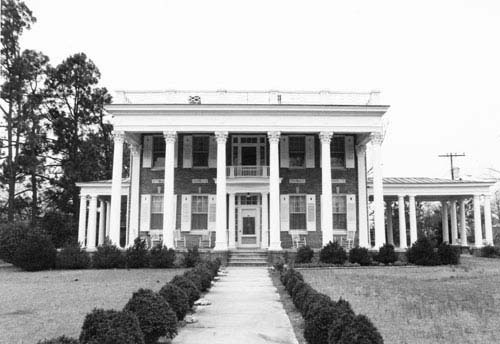
Front Facade
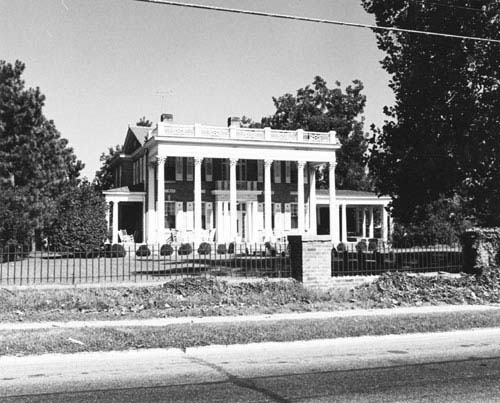
Left Oblique
The Manor is one of the best examples of early twentieth-century architecture built in Bishopville. Its Neo-Classical design was the work of architect J.H. Johnson of Sumter. It was begun in 1914 but was not completely finished until 1918. The house was built by Edward Tisdale who was one of Bishopville’s leading cotton merchants of the early twentieth century. Tisdale was a farmer and businessman who lived in Sumter until the early 1900s. He moved to Bishopville during its boom years to take advantage of the growing cotton industry. Tisdale amassed a sizeable fortune through the cotton industry by 1914 when he began his house on Main Street. The house is a two-story, rectangular brick building with a gable roof and two interior brick chimneys. On the main façade is a free standing, two-story portico with six wooden Corinthian columns. Above the columns is an entablature with round medallions in the frieze and dentils. On the roof of the portico is a balustrade and decorative railing. The interior details include coffering in the ceiling, dentils, urn and garland designs and other classical motifs. At the rear of the house are two original, one-story brick, hipped roof buildings which serve as a garage and storage area for the main house. Listed in the National Register January 9, 1986.
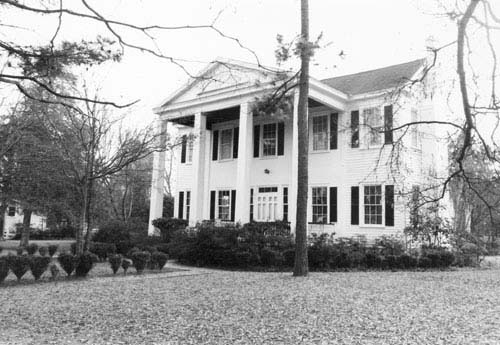
William Rogers House, Front Elevation
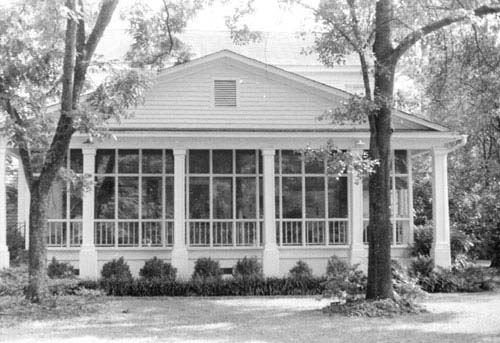
William Rogers House, Rear Elevation
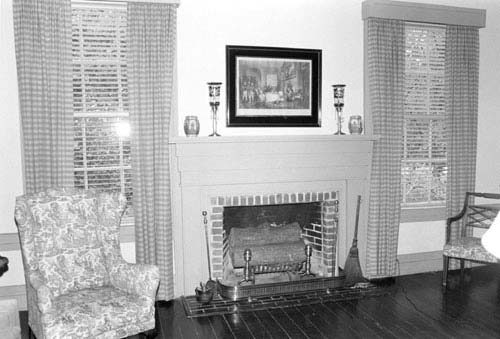
First Floor Mantle
The William Rogers House was built ca. 1845 in a vernacular interpretation of the Greek Revival style. The front façade features a large two-story pedimented portico. This portico has four large square, frame columns with Doric motif capitals. In the gable field of the pediment is an elliptical blind window with sawtooth wood shingles. The three central bays of the house on the main facade have narrow flushboard siding with wider weatherboard siding on the rest of the house. The house has two exterior end brick chimneys with a stucco finish. At the rear of the building are several one-story additions made in the late nineteenth century. The interior of the house retains its original woodwork, staircase, and mantels. During the early 1840's, William Rogers, a Connecticut native, moved to Bishopville to open a store. In 1850, Rogers is listed as residing in Bishopville with his wife and seven children. Roger’s grandson was Thomas G. McLeod, who served as South Carolina’s governor from 1923 to 1927. During his childhood McLeod was a frequent visitor to this home but there is no evidence that he ever resided here. The Rogers family continued to own this house until the 1890's when it was sold to the Tatum family. Listed in the National Register January 9, 1986.
South Main Street Historic District, Lee County (Bishopville)
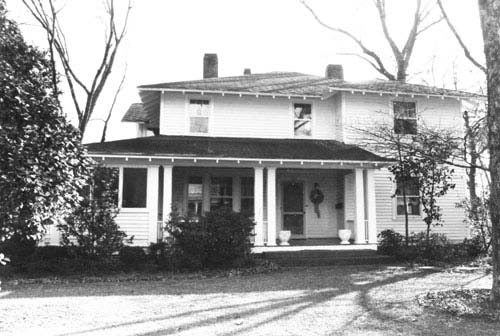
Deschamps House, 327 S. Main St. (Constructed: ca. 1920)
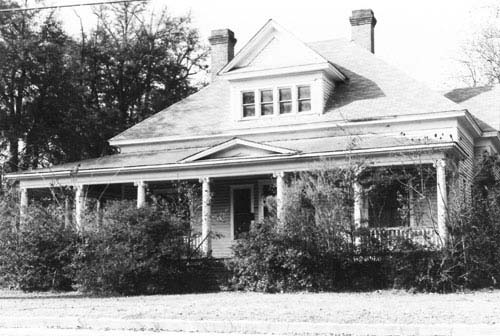
G. Parrott House, 240 S. Main St. (Constructed: ca. 1913)
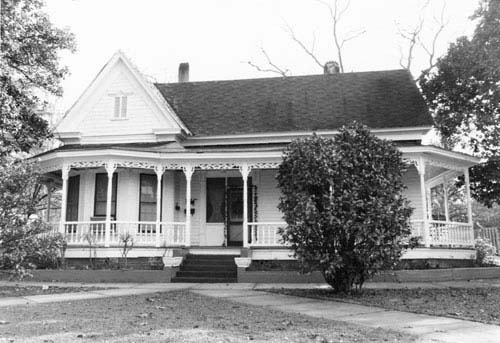
Furman G. Parrott House, 321 S. Main St. (Constructed: ca. 1890)
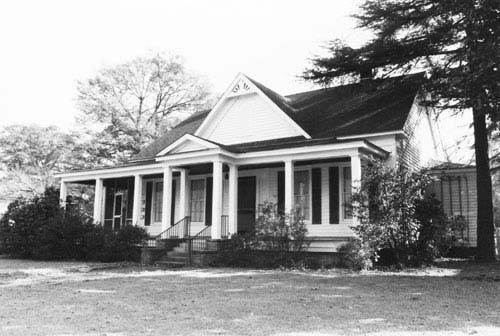
McLendon House, 315 S. Main St. (Constructed: ca. 1910)
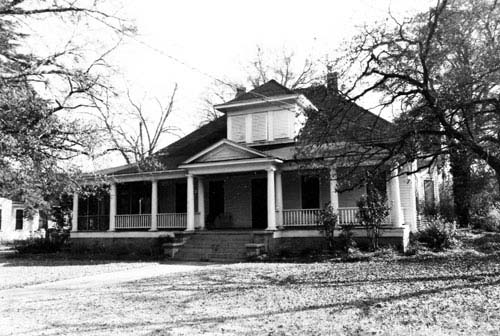
Moore-Dubose House, 305 S. Main St. (Constructed: ca. 1900)
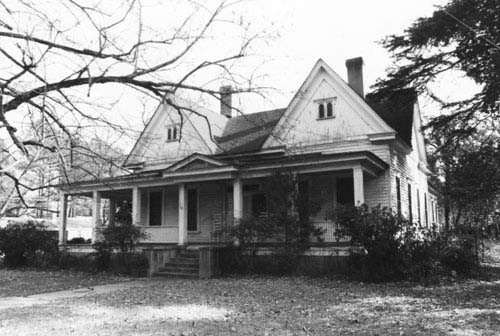
McCutheon House, 301 S. Main St. (Constructed: ca. 1905)
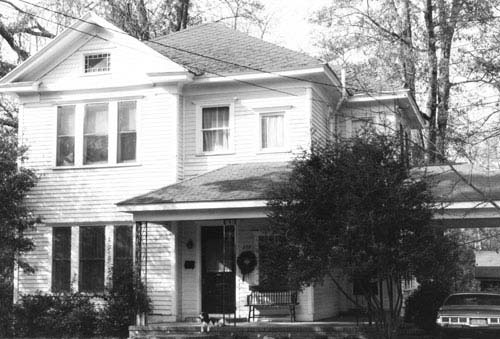
C. Reams House, 222 S. Main St. (Constructed: ca. 1903)
The South Main Street Historic District consists of eleven residences constructed between ca. 1880 and ca. 1925. The district is the best remaining concentration of historic residential architecture in Bishopville. The district evolved after 1880 when the community grew as a cotton shipping and trading center, and later as a county seat. Many of the houses along South Main were built by the town’s merchants and government officials. The district contains a fine grouping of late nineteenth and early twentieth century residences reflecting the vernacular Queen Anne, Colonial Revival and Bungalow styles. While there are small groupings of turn-of-the-century residences in Bishopville, the South Main District is the largest and most cohesive center of historic residential architecture in the community. Listed in the National Register January 9, 1986.
Spencer House,
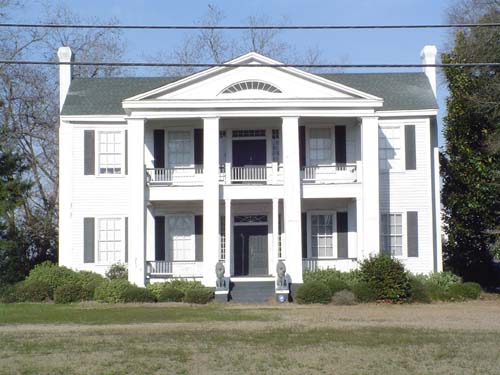
Front Facade
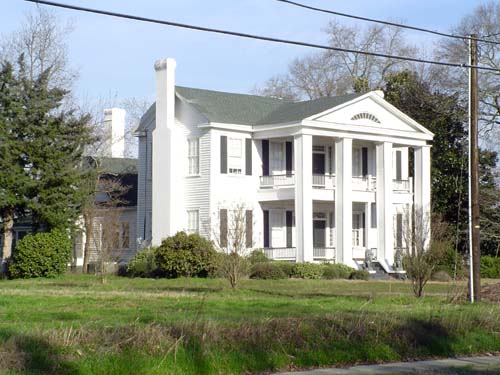
Left Oblique
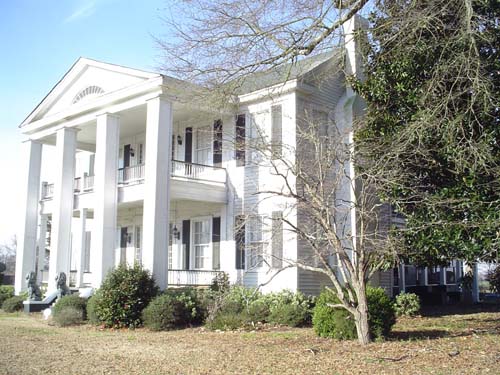
Right Oblique
The Spencer House is a notable vernacular Greek Revival residence constructed ca. 1845. It was constructed by Charles Spencer, a leading Bishopville merchant of the nineteenth century. A house is shown on this site in 1821 and part of this original home may have been retained in the ca. 1845 construction. The main section of the house is a large two-story, frame structure. On the main façade is a two-story, pedimented portico supported by four square frame pillars with Doric motif capitals. In the gable field of the pediment is an elliptical sunburst design. On the second story behind the portico is a balcony with a rectangular railing and spindles. At the rear is a one-story, gable roof ell with a large exterior brick chimney. Spencer, a native of Connecticut, moved to Bishopville in the early 1840s and along with his partner and relative, William Rogers, he operated one of Bishopville’s most prominent stores of the mid-nineteenth century. Spencer also served as Bishopville’s postmaster from 1845 to 1866. Family legend states that Spencer modeled his home after Rogers’ which was built several years earlier. The two houses are both very similar in floor plan and appearance. Listed in the National Register January 9, 1986.
Tall Oaks, Lee County (811 W. Church St., Bishopville)
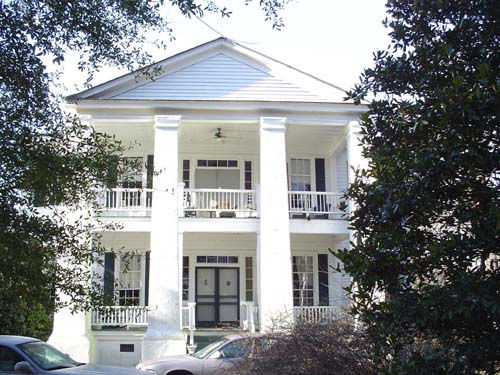
Fasade
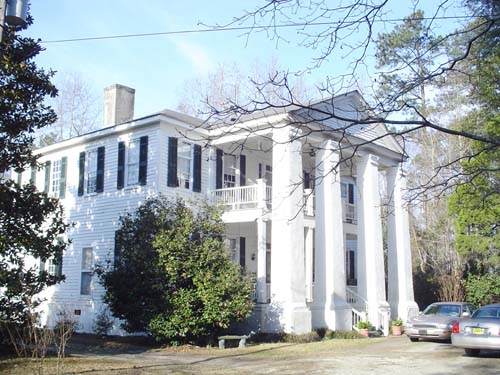
Left Oblique
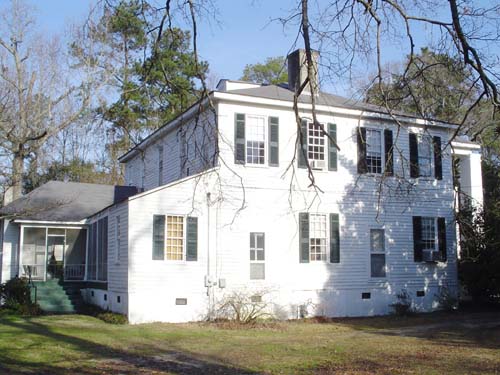
Rear Oblique
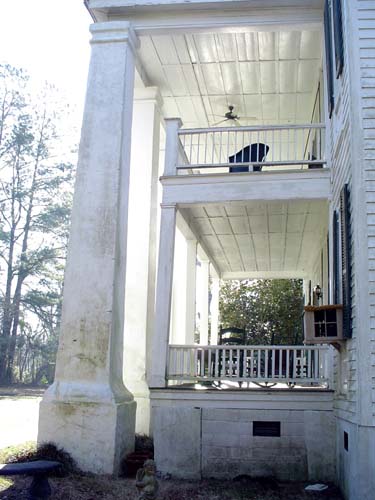
Rain Porch Detail
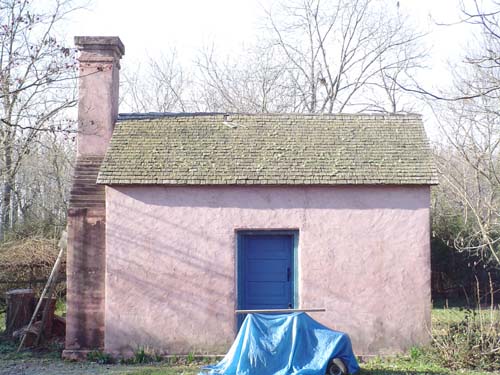
Out Building, Kitchen
(S. McLendon House) Tall Oaks, built ca. 1847, is a good example of a two-story vernacular Greek Revival residence. The house has a hipped roof and rests on a brick foundation. On the front façade is a two-story, gable-roofed pedimented portico with four large columns. These columns are of brick construction with a stucco finish and Doric motif capitals. At the rear of the house is a shed roof and hipped roof porch addition added ca. 1910. The interior retains its original woodwork, wainscoting, mantels, and paneling. An original brick kitchen still stands behind the main house. This kitchen has a large corbeled brick chimney, water table, and gable roof. Tall Oaks is associated with a notable Bishopville family of the nineteenth and early twentieth centuries. The house was built by Dr. John Edward Dennis. Dennis was born in Virginia in 1802 and he moved to Bishopville in the 1820s. Dennis was both a prosperous physician and farmer and in 1847 he constructed this large frame house which he named Tall Oaks for the many surrounding large oak trees. His son, Robert Dennis continued to live in the house and practiced medicine in Bishopville until his death in 1904. Listed in the National Register January 9, 1986.
Tanglewood Plantation
 Front Fasade
Front Fasade 
East Side of Home

Center Hall

Dining Room

Master Shower

Master Bath

Master Sitting Room

Front Parlor
(Ellison Durant Smith House) Tanglewood Plantation was built by the Rev. William H. Smith (1819-1882) c. 1850. A two-story clapboard structure, Tanglewood was the home of several outstanding South Carolinians who were involved in both religious and political affairs. Among these were Ellison Durant “Cotton Ed” Smith, United States Senator from 1908 to 1944, and Alexander Coke Smith, Bishop of the Methodist Conference from 1902 until 1906. The house is typically Greek Revival in style, featuring a two-story pedimented front portico with symmetrical bays on either side, double entrance on both floors, and interior decorative motifs. The portico is supported by four square columns on freestanding brick piers and is divided into an upper and lower gallery. The house is supported by brick piers, the spaces between which have been filled in with new brick construction. Twin interior chimneys with corbeled caps protrude through the roof at its crest. There are also two exterior chimneys. A two-story projecting wing was added to the west façade in 1915, as well as a kitchen ell alteration to the south (rear) façade. Outbuildings include a pine clapboard kitchen building, a round-cut log constructed smokehouse, and a one-room schoolhouse. Listed in the National Register September 22, 1977.
U.S. Senator Ellison DuRant "Cotton Ed" Smith was a legend in his time. He was born at his ancestral home, Tanglewood Plantation (formerly Smith's Grove), in 1864, during the War between the States. Tanglewood is located in lower Lee County on SC Hwy 341 near Lynchburg. In 1864 this area of Lee County was part of the Old Sumter district. After the war, it was redistricted and named in honor of Robert E. Lee.Cotton Ed's father was William Smith, a Methodist minister. His grandfather was Jesse Smith and his great grandfather was Arthur Smith. Arthur migrated from Smith Island, NC, and received his first land grant for Tanglewood Plantation from King George II in 1747. The first plantation house, a two story cypress log home, burned in the early 1800's. The present 2 1/2 story Greek Revival mansion was built on the same site as the original house in 1830 using materials and labor from the plantation.
Senator Smith's father married Isabella McLeod, known as "Miss Bella." Miss Bella's nephew, Ellison's first cousin, was Governor Thomas McLeod. Ellison D. Smith was the youngest of several children. His brother, Coke Smith, was the Methodist Bishop of Virginia. His sister, Anna Belle, married John Andrew Rice, Sr., a past president of Columbia College. John Andrew Rice, Jr. was born at Tanglewood Plantation and was a famous writer and Pulitzer Prize winner, publishing many award winning books and contributing to Collier's Magazine.Ellison Smith graduated from Wofford College and returned home to farm his plantation lands. He first married at the age of 28 to Martha Moorer of St. George, SC. She died giving birth to their son Martius Ellison. At 19 Martius was accidentally shot by his own gun while drinking water at the barnyard well. He died five days later.
In 1906 Ellison married Annie Brunson Farley. Her uncle Henry Farley fired the first shot in the Confederate Army, serving under J.E.B. Stewart, and gave his life for the Southern cause. Ellison and Annie had four children of their own, two boys and two girls. Their oldest daughter, Anna, was married to L.L. Smith, vice president of Kohler Plumbing Co. of Wisconsin. Isobel Smith Lawton moved to Florence, SC, when she married. Ellison DuRant, Jr. married Vivian Manning, daughter of Governor Manning. Charles Saxon Farley, a past member of the SC Legislature from Lee County, married Laura Douglas. Laura was the daughter of Oscar Douglas (co-founder of the F.W. Woolworth empire.) All five of Ellison DuRant Smith's children are now deceased.
Ellison Smith, who inherited the plantation, was a farmer with vision. In 1901 he organized the Farmer's Protective Association. In 1905 he was a leader in the Boll Weavil Convention in Shreveport, LA. He later organized the Southern Cotton Association in New Orleans and was elected its first president.
Ellison Smith served in the SC Legislature from 1896 to 1900. In 1908 he was elected to the U.S. Senate and served for 36 years, longer than any other Senator in the history of the U.S. at that time. He was Chairman of the Agriculture and Forestry Committee in the Senate. He also was Chairman of the Interstate Commerce Committee. In 1940 he was elected Dean of the Senate. His close involvement in cotton and farm issues made him internationally known as "Cotton Ed" Smith. He believed in the Constitution of the U.S., and worked tirelessly until his death in 1944.
Ellison Smith died at Tanglewood Plantation in the same bed he was born in. He is buried at St. Luke's Cemetery near Wisacky in Lee County.
Notable natives
- Bishopville is where college football legend, and 1945 Heisman Trophy winner, "Mr. Inside" Felix "Doc" Blanchard was born. The Interstate 20 / U.S. Route 15 interchange near Bishopville is named the Felix "Doc" Blanchard Interchange. The sportsman and pilot will also be commemorated with three bronze statues, scheduled to be unveiled near the public library in December 2009. These statues will depict Blanchard in separate phases of his life. This would appear to conflict with the linked Wiki entry for Blanchard indicating he was born in McColl, SC.
- Pearl Fryar noted topiary artist.
- Tommy Gainey professional golfer on the PGA Tour.
- Silas DeMary a player for the Cleveland Gladiators, an Arena Football League team.
- Drink Small the "Blues Doctor", an African American soul blues and electric blues guitarist, singer, and songwriter. Born on January 28, 1933
- The Button King, born Dalton Stevens, currently resides and showcases his button artwork in Bishopville.
External links:
Bishopville, Website
"A Man Named Pearl"
Pearl Fryar